Bayer R.G. Mechanical Wear Fundamentals and Testing, Revised and Expanded
Подождите немного. Документ загружается.

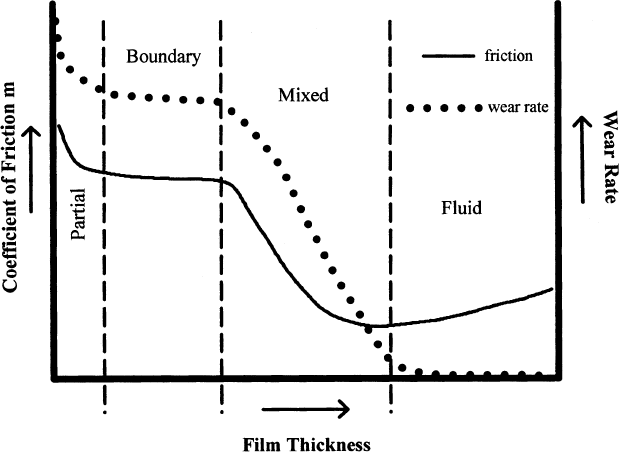
increase in friction results from the viscous flow of the lubricant. The improvement in wear
behavior is related to reduction in sliding wear that lubrication produces. In rolling con-
tacts, there is always some sliding, if only on a micro-scale as a result of deformation that
occurs (2). As a result, some sliding wear is involved and adhesion can play a role in rolling
wear behavior. A lubricant will tend to inhibit the adhesive contribution to the wear, limit
and reduce surface traction (stresses), and provide separation, all of which tend to reduce
sliding wear.
The ability of a material to lubricate is a function of its thickness and indirectly the
amount. There is a minimum thickness or amount required for maximum effectiveness.
This behavior with fluid lubricants is illustrated in Figs. 6.1–6.3. With solid lubricants,
the behavior is somewhat different. There is often an optimum thickness range, as illu-
strated in Fig. 6.4.
Lubricants can be liquids, gases, or solids (6–8) . Examples of solid lubricants are
PTFE, molydisulfide (MoS
2
), graphite, and soft metals, such as lead. Oils are examples
of liquid lubricants but this category is not necessarily limited to them. For example, water
coolants, refrigerants, and even inks, can provide some lubrication (6,9,10). Also, greases,
which are mixtures of oils and thickening agents, are generally considered to be liquid
lubricants. Greases are thought to function in two ways. One is as a very viscous fluid
and the other is as a reservoir for the oil component. For this latter mode, the concept is
that oil leaches out of the grease that surrounds the contact to cover the contact zone (11).
The class of liquid lubricants includes a wide range of materials with significantly different
rheological properties. As classes, liquid and gaseous lubricants generally have the prop-
erty of self-healing, which is the tendency to flow back into the region of contact, reple-
nishing any of the lubricant that is displaced during the wearing action. Solid lubricants
do not have that ability and, as a result, the durability of the soli d lubricant is often a
Figure 6.1 Behavior of wear rate and friction coefficient as a function of the thickness of liquid
lubricant.
Copyright 2004 by Marcel Dekker, Inc. All Rights Reserved.
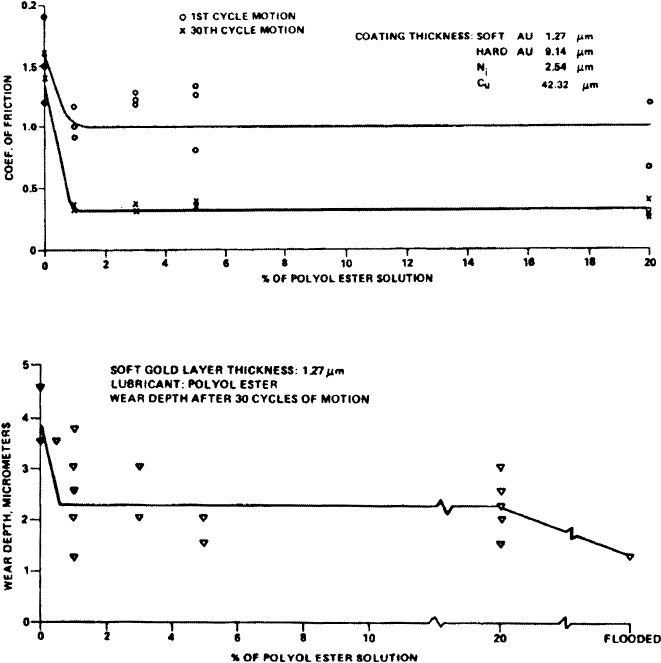
factor in engineering situations. Local wear-through of the solid lubricant layer can result
in degraded or complete loss of lubrication in the contact region. When this type of lubri-
cant is used, an underlying friction or wear problem is translated into a wear concern with
the solid lubricant itself.
This is illustrated by the behavior of a MoS
2
coating used in a band printer appli-
cation (12). When present, the coating significantly reduced the wear of the interface.
A sharp increase in wear occurred with the local depletion of the MoS
2
coating. The
durability of this coating was found to be dependent on the processing parameters and
the initial wear problem of the interface was converted to optimizing the process for the
coating to obtain adequate life. The influence of the MoS
2
coating on wear and the influ-
ence of processing parameters on durability of the MoS
2
are shown in Fig. 6.5.
Liquid lubricants can also exhibit ‘‘wear-out’’ characteristics but for different
reasons. Liquids can evaporate and spread over available surfaces so that, with time,
the amoun t of lubricant available to the contact interface can decrease. Therefore, if an
adequate supply is not maintained, the system will ultimately go dry. Also , the lubricant
Figure 6.2 Effect of the amount of lubricant on the friction and wear of an electrical contact.
The contacts were coated with the lubricant diluted with different amounts of a solvent, which after
evaporation of the solvent, resulted in different amounts of residual lubricant on the surfaces.
(From Ref. 33.)
Copyright 2004 by Marcel Dekker, Inc. All Rights Reserved.
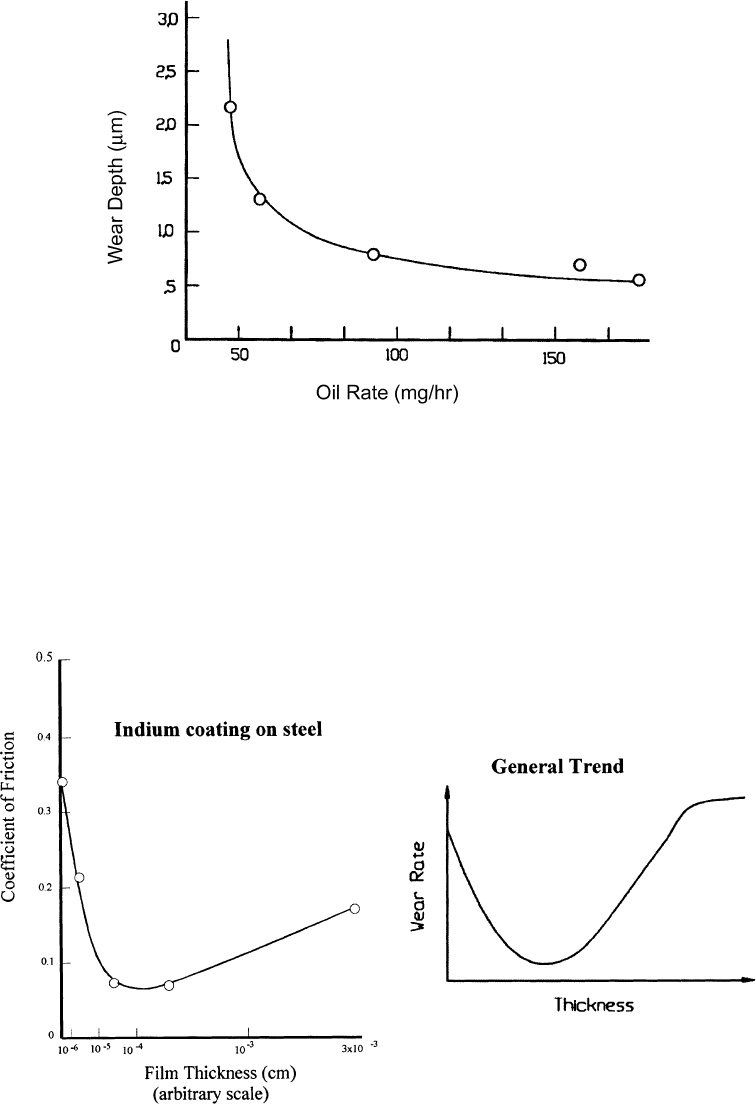
may degrade with time as a result of oxidation, polymerization, or some other mechanism,
with the consequence that the ability of the fluid to lubricate the contact may degrade (13).
Another aspect of lubrication is that the ability of a material to provide lubrication
can change as a result of the conditions surrounding the contact. Pressure, temperature,
Figure 6.3 Effect of lubricant supply rate on the wear of a type carrier in a high speed line printer.
(From Ref. 34.)
Figure 6.4 Illustration of the general effect of the thickness of a solid lubricant film on friction
coefficient and wear rate. (From Ref. 35 reprinted with permission from Oxford University Press.)
Copyright 2004 by Marcel Dekker, Inc. All Rights Reserved.
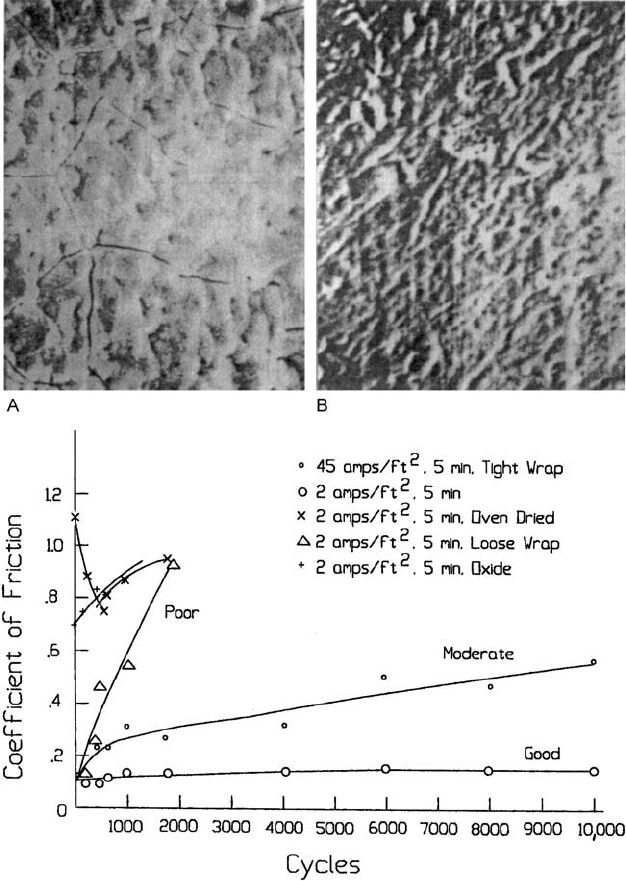
sliding speed at the interface, and material compatibility can all be factors in determining
the degree to which any material can function as a lubricant or, as will be discussed later
in this section, the manner by which it provides lubricati on. As a consequence, there is
generally more distinction in lubricant perfor mance when they are used in harsher, more
challenging wear and friction environments, such as in tribosystems with high speeds,
pressure and temperature, than in milder wear situations. However, even in the milder
situations, there can be significant differences in performance (1). Many of the tests used
Figure 6.5 Micrographs of MoS
2
conversion coatings resulting from poor (‘‘A’’) and good (‘‘B’’)
processing conditions. The graph shows the effect of processing conditions on the durability and
performance of the coating. (From Ref. 12.)
Copyright 2004 by Marcel Dekker, Inc. All Rights Reserved.
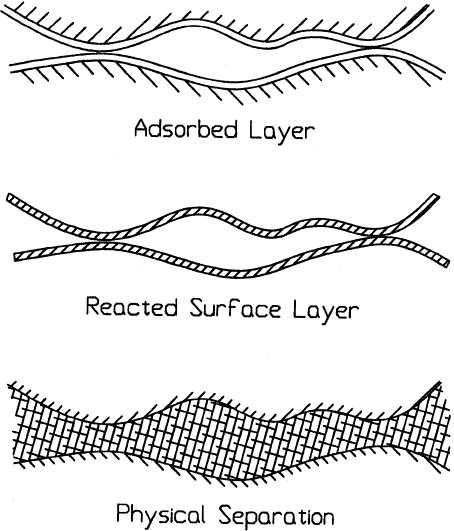
to evaluate, compare, and characterize lubricants focus on their ability to survive as effec-
tive lubricants under harsh or challenging conditions (14). These aspects of lubrication,
as well as others, such as supply of lubrication to the interface, make the selection of
lubricants and lubrication techniques a discipline in itself. Discussi ons of many of these
aspects can be found in references on lubricants and lubrication, such as Handbook of
Lubrication (15).
The primary way by which a lubricant influences friction and wear is by reducing
adhesion (5,9,14,16,17) and there are three general mechanisms for this. One is by absorp-
tion on the contact surfaces. The second is by chemically modifying the surface. The third
is by physical separation of the surfaces. These three ways are illustrated in Fig. 6.6. The
first two mechanisms tend to reduce the strength of the bonds at the junctions, while the
third tends to reduce the number of junctions. Secondary effects of lubrication are cooling
of the interface, modifications of the stresses associated with the contact, and flushing of
wear de bris or contamination from the contact region. Since lubricants tend to lower
friction, the heat and shear action developed at the contact interface is reduced. For fluid
lubricants, additional cooling occurs as a result of the lubricant transporting heat out of
the contact area. The lubricant can also influence the distribution of load within the
contact by supporting some of the load.
For fluid lubricants, mechanical separation results from the response of the lubricant
to being trapped between two surfaces under relative motion. Under such conditions,
a fluid can support a normal load, thus providing separation between the two surfaces
(5). Two exampl es of this type of response are shown in Fig. 6.7. In one case, the effect
is caused by the constriction of the fluid as a result of tangential relative motion between
Figure 6.6 Lubrication mechanisms.
Copyright 2004 by Marcel Dekker, Inc. All Rights Reserved.
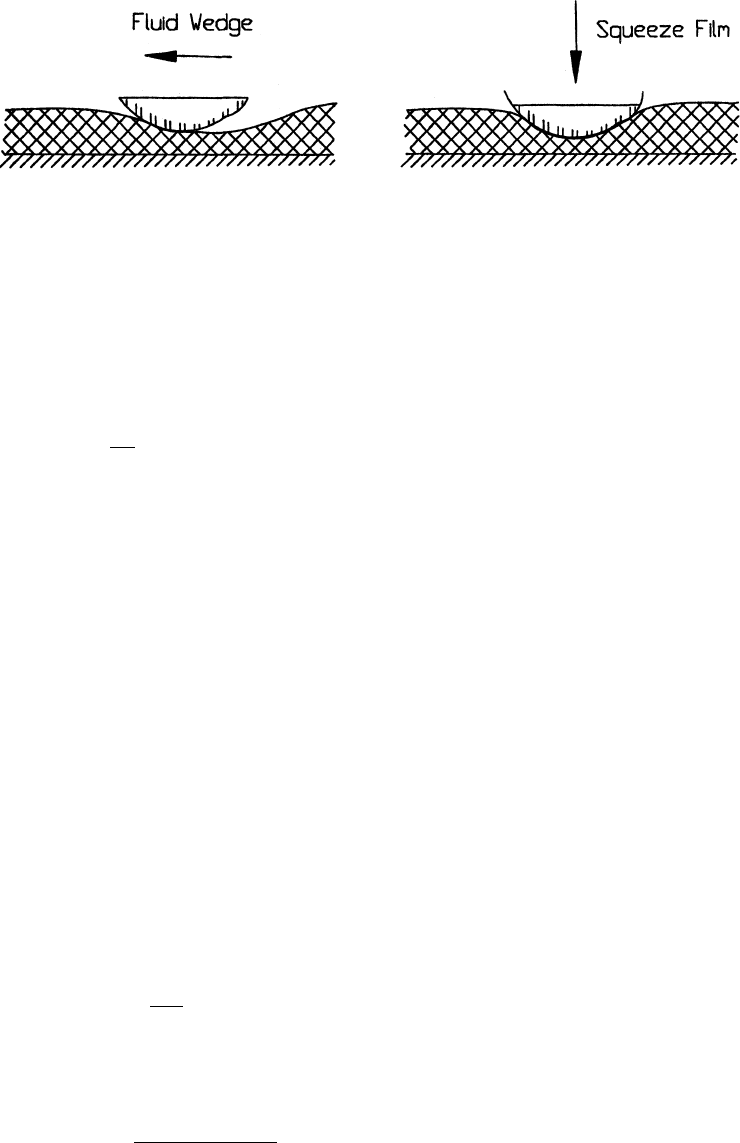
the surfaces, which is referred to as the physical wedge mechanism or simp ly the wedge
mechanism. The second mechanism is referred to as the squeeze film mechanism and
results from normal or perpendicular relative motion between the two surfaces. In both
cases, the film thickness that results is dependent on the load, geometry, and velocity of
the contact and rheological properties of the fluid .
For the wedge mechanism and a simple Newtonian fluid,
h /
tV
P
m
; 0:5 m 1 ð6:1Þ
where h is the minimu m thickness; V, the velocity; P, the normal load; and t, is the
viscosity. For more complex fluids, for example non-Newtonian fluids, the relationships
are more involved. Temperature gradie nts within the fluid and a pressure dependency
on viscosity can have significant effects on the existence and the thickness of these fluid
films. Under these conditions, sufficient pressure can be produced in the fluid so that
the surface can be deformed, resulting in local geometry changes (18–21). These changes
tend to enhance film formation and the ability of the fluid to support a normal load. With-
out deformation, lubrication by these types of fluid films is frequently referred to as hydro-
dynamic lubrication. For deformation of the surface within the elastic range, it is termed
elasto-hydrodynamic lubrication. If plastic deformation is involved, it is referred to as
elasto-plasto-hydrodynamic lubrication.
Investigations suggest that these additional aspects of deformation, temperature
distribution, pressure dep endency of viscosity, and non-Newtonian fluid pro perties, play
significant roles in this type of lubrication. The amount of lubricant available is also a
major factor. If there is not an adequate supply to the inlet of the contact, the film will
not form. As an illustration of the significance of some of these aspects in lubrication,
the pressure distributions and wedge shapes for a hydrodynamic model and an elasto-
hydrodynamic model for two spheres in sliding contact, are shown in Fig. 6.8 (22,23).
The equations for the film thickness are
h ¼ 4:9R
t
0
V
P
ð6:2Þ
for the hydrodynamic model and
h ¼ 2:65
a
0:54
t
0
VðÞ
0:7
R
0:43
P
0:13
E
0
0:03
ð6:3Þ
Figure 6.7 Squeeze films and physical wedges in fluid lubrication.
Copyright 2004 by Marcel Dekker, Inc. All Rights Reserved.
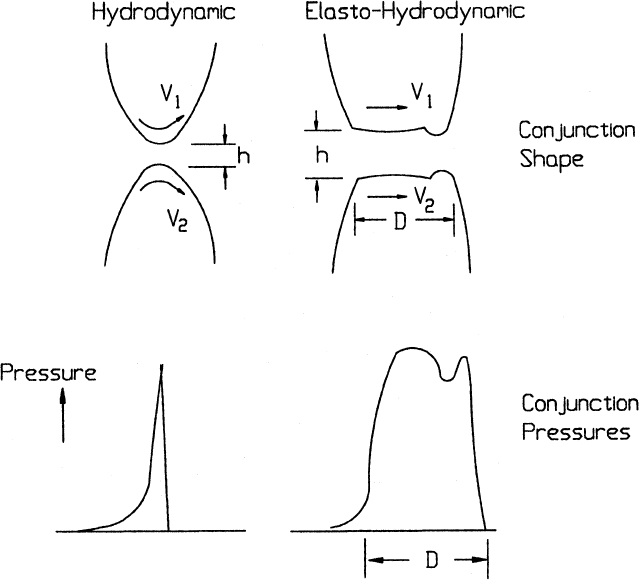
for the elasto-hydrodynamic model. t
0
is the absolute viscosity at the inlet; a is the pressure
coefficient of viscosity (allowed for in the elastohydrodynamic model); E’, the reduced
elastic modulus for Hertzian contacts; and R is the equivalent radius for the contact.
Overall, lubrication as a result of these types of film formation with fluid lubri-
cants is referred to as fluid lubrication. As can be seen, surface separation is the primary
way that this type of lubrication effects the amount of adhesion and the degree of separa-
tion is directly related to the relative speed between the two surfaces and the geometry. The
higher the speed and the flatter the geometries , the thicker the film formed. The other two
ways in which a fluid effects adhesive components of friction and wear, the formation of
absorption and chemical reacted layers, are generally referred to as boundary lubrication
and are not as directly sensitive to these two parameters. The formation, strength, and
tenacity of these films are primarily related to the chemical nature of the surfaces and
the lubricant (14,16,17,24,25). Boundary lubrication is frequently the key factor in lubri-
cation, especially under extreme conditions. The situation in which both boundary and
fluid lubrication occur is normally referred to as mixed lubrication.
In Fig. 6.9, the Streibeck Diagram is used to illustrate these three regions of lubri-
cation (18,26,27). This diagram shows the relationship between the coefficient of friction
and wedge formation under sliding condition s. It can be seen that the abscissa of this
diagram, the Sommerfeld Number, is related to the thickness of the lubricant layer, based
on fluid lubrication concepts [see Fig. 6.1 and Eq. (6.2)]. In the fluid lubrication region,
the film thickness is great enough so that the two surfaces do not interact at the asperity
Figure 6.8 Comparison of hydrodynamic and elasto-hydrodynamic models for wedge formation.
Copyright 2004 by Marcel Dekker, Inc. All Rights Reserved.
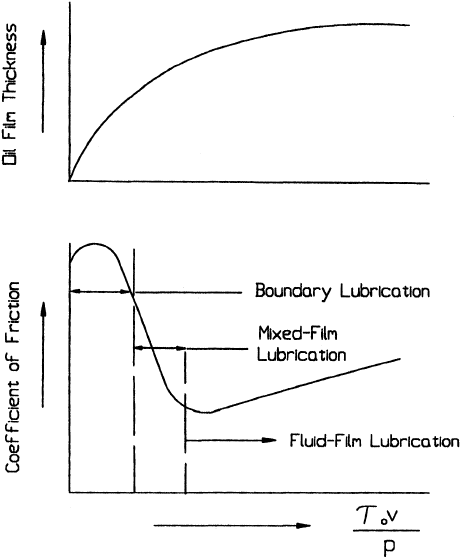
level. In the mixed region, the film thickness allows occasional asperity interacti on. In the
boundary region, the fluid film thickness is so smal l that it is ineffective in preventing
complete asperity interaction. Generally, wear decreases monotonically as film thickness
increases. In the fluid range, wear woul d be limited to repeated cycle deformation mecha-
nisms associated with the pressure transmitted through the fluid and is generally negligible.
As the film thickness decreases and more and more asperity contact occurs, the potential
for different wear mechanisms is introduced.
The trans ition from the mixed region to the fluid region is governed by the ratio of
the asperity heights to the film thickness. Conceptually, the film thickness should be
greater than the combined asperity heights of the two surfaces for complete separat ion
and to be in the fluid lubrication regime. For two rough surfaces, the film thickness
required for full fluid lubrication is given by
O ¼ bs
2
1
þ s
2
2
1=2
ð6:4Þ
where the s’s are the center line average (CLA) roughness of the two surfaces. Studies have
indicated that an average value for b is approximately 3 (18,19,28).
The basic concept of solid lubrication or lubrication by solids is that the lubricant or
lubricant=counterface junction is easier to shear than the base material or base materi-
al=counterface junction (26,29). In the case of solid film lubrication, a relationship between
Figure 6.9 Relationship of viscosity, t
0
, speed, V, and load, P, to the coefficient of friction and oil
film thickness. (t
0
V=P) is called the Sommerfeld Number and the lower diagram is referred to as the
Streibeck Diagram.
Copyright 2004 by Marcel Dekker, Inc. All Rights Reserved.

friction and film thickness also exists and is shown in Fig. 6.4. While the shap e of the curve
is quite similar to the shape of the curve in the Streibeck Diagram for fluids, the reasons
are quite different. Initially, for very small thickness of the solid lubricant, the coefficient is
reduced by reducing the number of strong adhesive junctions, without increasing the total
number of junctions or real area of contact. The real area of contact is controlled by the
harder substrate and the real area of contact is thought to be composed of a mixture of
junctions, ones without the solid lubricant present and ones with the solid lubricant
present. As the percent of junctions with the lubricant increases, the coefficient of friction
decreases. Mathematically, the situation is expressed by
m ¼ a
t
s
s
s
þ 1 aðÞ
t
1
s
s
ð6:5Þ
where a is the fraction of non-lubricated junctions; t
s
, the shear strength of the non-
lubricated junction; t
l
, the shear strength of the lubricated junction; d
s
, the flow stress
of the substrate. Since d
s
is greater than t
l
, m decreases as a decreas es.
In the second region, the film is continuous and all junctions involve the lubricant
and the lubricant influences the real area of contact. Because the solid lubricant is softer
than the substrate, the real area of contact would tend to increase, leading to increased
friction. For very thick films, the coefficien t of friction would be the coefficient of friction
associated with the solid lubricant and the counterf ace. Since the coefficient of friction
involves the ratio of the shear strength to the compressive strength, the friction between
the lubricant layer an d the counterface may be higher than that between the substrate
and the coun terface. Models indicate that the approximate relationship between friction
and thickness is
m /
h
P
1=2
ð6:6Þ
where h is the thickness of the solid lubricant and P is the normal load (30).
While effective friction behavior as a function of thickness is similar for fluid and
solid lubrication, wear behavior is different. Generally for solid lubricati on, there is an
optimum thickness for wear behavior. If there is not enough solid lubricant, the wear of
the surfaces is not significantly effected; if there is a very thick layer, the wear of the system
will be the wear of that layer. Since solid lubricants generally have poorer wear properties
than the base materials, the effective wear will be initially higher than without lubrication.
As the lubricant layer thins, the optimu m condition will be produced and improved wear
behavior achieved. However, since solid lubricants do not self-heal, there will be a finite
time for this period and eventually wear performance will degrade again. Graphically, this
behavior is shown in Fig. 6.4.
While the conceptually solid lubrication can be considered simply in terms of thick-
ness and coverage, the actual situation can be more complex. Optimum behavior may
involve the formation of a mixed layer on the surface, composed of elements from the
lubricant and the base materials. Thi s layer would function, much like a transfer or
third-body film in influencing wear and friction. Unlike these films, the solid lubricant
equivalent will have a finite life since the lubricant is not replenished.
In addition to the film type of lubrication discussed to this point, lubrication to an
interface can also be provided by utilizing materials, which have lubricants ‘‘built-in’’.
Examples of this type would be polymers, which have lubricating fillers, like PTFE,
Copyright 2004 by Marcel Dekker, Inc. All Rights Reserved.
MoS
2
, and graphite. An example in metallic systems would be metals, which have lubricat-
ing phases in them, such as leaded steels. These generally fall under the category of self-
lubricated or self-lubricating materials. In this case, lubrication is usually achieved by
transfer and third-body film formation. Hard phases and fillers can also be added to mate-
rials to improve wear resistance. Still another example would be porous materials filled
with a solid or liquid lubricant, such as oil impregnated sintered bronze journal bearings.
In this case lubrication can occur by boundary and fluid lubrication mechanisms (27,31).
Circulation of the fluid through the por ous media is an additional factor that needs to be
considered in the fluid lubrication process of these types of bearings.
Because friction and wear are distinct, the ranking of lubricants in terms of their
ability to lubricate can be different for friction and wear. Within the realm of lubricated
systems, it is frequently found that while lubricant A gives lower friction than B, there
is less wear with B (1,32). While there are these differences in the effectiveness of lubri-
cants, they are generally not as significant as the differences between lubricated and unlu-
bricated conditions. This can be paraphrased by saying that in most cases the biggest
improvement obtained in wear and friction performance is associated with the use of
any lubricant; a secondary improvement is associated with the selection of a particular
lubricant for the system. In terms of wear, the change from unlubricated to lubricated
wear generally results in improvement by more than one order of magnitude, with an
improvement of 100 times or more being typical. Differences between lubricants are often
smaller but can be significant. For lubricated sliding, m is generally less than 0.3; under
unlubricated conditions, m frequently exceeds 0.6. For rolling, m is less than 0.01.
(see Table 5.2).
REFERENCES
1. R Bayer, T Ku. Handbook of Analytical Design for Wear. New York: Plenum Press, 1964.
2. F Bowden, D Tabor. The mechanism of rolling friction. The Friction and Lubrication of
Solids, Part II. New York: Oxford University Press, 1964, pp 277–319.
3. F Bowden, D Tabor. The mechanism of rolling friction. The Friction and Lubrication of
Solids, Part II. New York: Oxford University Press, 1964, pp 318.
4. M Todd. Solid lubrication of ball bearings for spacecraft mechanisms. Trib Intl 15(6):331–338,
1982.
5. M Neale, ed. Tribology Handbook. New York: John Wiley and Sons, 1973.
6. E Booser, ed. Handbook of Lubrication, Vol. II. Boca Raton, FL: CRC Press, 1983.
7. F Ling, E Klaus, R Fein, eds. Boundary Lubrication. ASME, 1969.
8. N Soda, T Sasada. Mechanism of lubrication of surrounding gas molecules in adhesive wear.
Proc Intl Conf Wear Materials ASME 47–54, 1977.
9. F Bowden, D Tabor. The Friction and Lubrication of Solids. New York: Oxford U. Press,
Part I, 1964, and Part II, 1964.
10. R Bayer, J Sirico. Influence of jet printing inks on wear. IBM J R D 22(1):90–93, 1978.
11. I Rugge, E Booser, eds Lubricating greases-characteristics and selection. Handbook of
Lubrication. Vol. II. Boca Raton, FL: CRC Press, 1983, pp 255–267.
12. R Bayer, A Trivedi. Molybdenum disulfide conversion coating. Metal Finishing. Nov:47–50,
1977.
13. G Pedroza, C Pettus. NLGI Spokesman. Sept:203, 1972.
14. R. Fein. Presentation at the IRI Conference on Tribology. Warren, MI: GM Research Labs,
22–23 Jan 1985.
15. E Booser, ed. Handbook of Lubrication. Vols. I, II and III. Boca Raton, FL: CRC Press.
16. A Beerbower. Boundary Lubrication, Scientific and Technical Applications Forecast. U.S.
Army Research and Development, Contract No. DAHC 19–69-C-0033, 1972.
Copyright 2004 by Marcel Dekker, Inc. All Rights Reserved.
